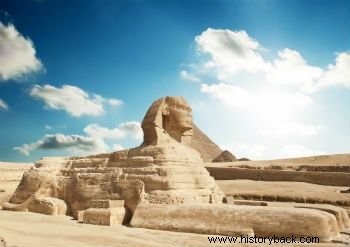The Sphinx of Giza or Great Sphinx of Giza is a giant monument, erected at the time of Ancient Egypt that is located near the Pyramids of Egypt, on the west bank of the River Nile, on the outskirts of Cairo.
The presence of the three pyramids (Chephren, Cheops and Menkaure) and the Sphinx as a guardian, makes the Necropolis of Giza one of the most famous archaeological sites in Africa and the world.
The Sphinx is located on the Giza Plateau in Egypt (Africa), researchers believe that the date of its construction was around 2500 BC, during the reign of Pharaoh Khafre; however, some point out that its age is much older:erected in 10,000 BC.
The term sphinx derived from the Egyptian language “shesep-ankh ”, which means “living image”, that is, she would act as a guardian of the Giza Peninsula, representing the strength of the Pharaoh.
Learn more about The Pyramids of Egypt.
History
 Sphinx of Giza
Sphinx of Giza
History portrays that the Sphinx was built with the head of Pharaoh Khafra. For the Egyptians she represented a deity:the Sun God “Atum Ra”.
Legend has it that around 1400 BC. Thutmose IV rested next to the Sphinx and had a dream with the Sun God, asking him to remove the sand that covered it, in exchange, the God would transform him into a great Pharaoh.
Between the immense paws of the lion, it is possible to find a slab of red granite (Dream Stele) describing this passage. Some scholars believe it was painted red, however over time the color faded away.
With sandstorms in place, the sphinx's body was completely covered for millennia, being fully discovered in 1925. In addition, it has been restored several times and is currently one of the most visited monuments by tourists from around the world.
Learn more about aspects of Egyptian Civilization.
Sphinx Structure
The Sphinx has an interesting structure based on a mythical figure that includes a lion's body and a human head with a royal turban facing the direction of the rising sun. For the Egyptian people, the lion represented an important figure of protection.
Made of limestone, it is 73 meters long, 19 meters wide and 20 meters high and represents the largest Sphinx on the planet and the largest statue carved from a large stone block.
See also:PharaohThe Sphinx Inside
Inside the sphinx mummies were found, since it is part of Egyptian mortuary mythology to mummify the important dead and place them inside large monuments in order to protect them. In the Egyptian culture the pharaohs were eternal and therefore the importance of conserving their bodies.
To expand your knowledge, read the article:Egyptian Art.
Mysteries of the Sphinx of Giza
One of the biggest mysteries about the Sphinx is related to the date when the monument was erected and the loss of the nose, one meter wide. Many hypotheses revolve around this issue, whether due to loss in one of the Napoleonic invasions, or even erosion caused by time. However, the most accepted among historians is that some enemy peoples tore off the statue's nose, since in the old days this meant losing honor.
Fun facts:Did you know?
In the mouth of the Sphinx is an inscription that reads:“I protect the chapel from your tomb. I keep your burial chamber. I keep intruders away. I throw enemies to the ground with their own weapons. I expel the wicked from the chapel of the sepulcher. I destroy your opponents in their hiding places, blocking them so they can't get out anymore .”
